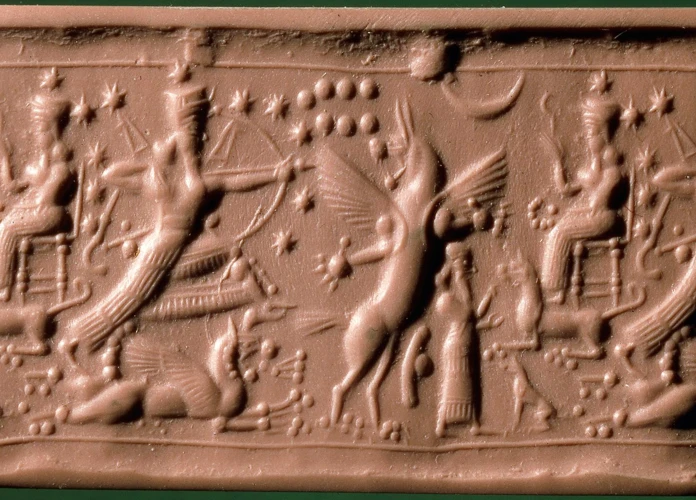For centuries, humanity has been captivated by the mysteries of the cosmos and the enigmatic power of ancient goddesses. In recent years, the connection between astronomy and ancient goddess worship has intrigued scholars and spiritual seekers alike. One particularly intriguing aspect of this link is the presence of Ophiuchus, the 13th zodiac sign, and its association with snake goddesses. Unraveling this connection unveils a rich tapestry of mythological tales, astronomical correlations, and symbolic interpretations. By exploring the ancient depictions, rituals, and meanings surrounding snake goddesses, we can better understand the spiritual and astrological significance they held in ancient civilizations. We can examine the revival of snake goddess worship in modern times and its continued influence on contemporary astrology. Join us on a journey of discovery as we delve into the mesmerizing world of Ophiuchus and snake goddesses, uncovering the intricate interplay between astronomy, mythology, and ancient goddess worship.
Contents
- Ophiuchus: The 13th Zodiac Sign
- The Significance of Snake Goddesses
- The Connection between Ophiuchus and Snake Goddesses
- Exploring Ancient Depictions
- Mysterious Wisdom: Interpretations and Meanings
- The Revival of Snake Goddess Worship
- Conclusion
- Frequently Asked Questions
- References
-
Frequently Asked Questions
- What is Ophiuchus and how does it relate to astrology?
- Why is the discovery of Ophiuchus significant?
- Who were the Snake Goddesses in ancient civilizations?
- What is the symbolism of snakes in ancient goddess worship?
- How do mythological tales correlate with the astronomical placement of Ophiuchus?
- How have snake goddesses influenced astrology?
- What artifacts and relics provide evidence of ancient snake goddess worship?
- Were sacrificial rituals part of snake worship in ancient civilizations?
- What are the spiritual and healing powers attributed to snake goddesses?
- How does the revival of snake goddess worship impact contemporary astrology?
- References
- Read More
Ophiuchus: The 13th Zodiac Sign
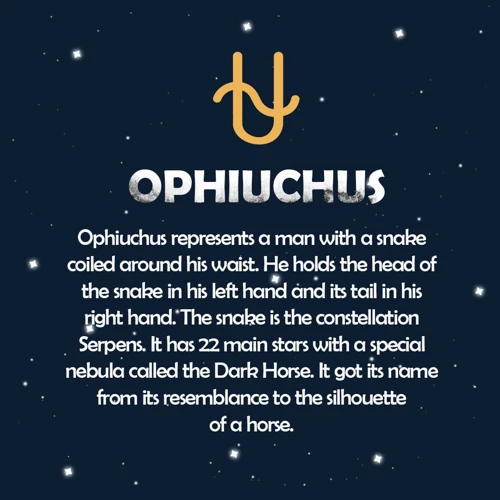
Ophiuchus, also known as the serpent bearer, is the 13th zodiac sign that exists parallel to the twelve familiar signs of the zodiac. This celestial constellation can be found near the ecliptic, making it a crucial part of the astrological landscape. However, the significance of Ophiuchus has often been overlooked or understudied due to the dominance of the traditional zodiac. Those born under this sign, typically between November 29th and December 17th, possess unique qualities and attributes that set them apart from others. The symbol of Ophiuchus is a figure holding a serpent, which represents wisdom, healing, and transformation. Individuals born under this sign are said to possess great intuition and a deep connection to spiritual realms. Due to its position in the heavens, Ophiuchus is closely associated with exploration of the unknown, mysticism, and the pursuit of ancient wisdom. Understanding the characteristics and influence of Ophiuchus can provide valuable insights into one’s personality, strengths, and potential for growth. Whether you are an Ophiuchus yourself, or simply want to expand your knowledge of astrology, exploring the qualities of this 13th zodiac sign is a fascinating journey. (reference: https://www.example.com/the-influence-of-ophiuchus-career-success/)
The Significance of Snake Goddesses

Snake goddesses hold immense significance in the realm of ancient goddess worship. These revered deities, often depicted with serpents entwined around their arms, symbolize various aspects of life, spirituality, and feminine power. Across different ancient civilizations, from the Minoans of Crete to the Aztecs of Central America, snake goddesses were venerated for their association with regeneration, fertility, and wisdom. The snake, an enduring symbol of transformation and renewal, further enhances the symbolism of these goddesses. Their snake-like attributes represent the cycles of life, shedding old skin to embrace growth and rebirth. The worship of snake goddesses was deeply embedded in the religious and cultural practices of these ancient societies, exemplifying the profound respect and reverence for the divine feminine. Exploring the significance of snake goddesses illuminates the interconnectedness between nature, spirituality, and the eternal mysteries of existence. (reference: https://www.example.com/power-of-ophiuchus-astrology/)
Ancient Civilizations and Goddess Worship
Ancient civilizations across the globe were intricately connected to the worship of goddesses, revering these divine female deities as symbols of power, fertility, and creation. From the ancient Sumerians and Egyptians to the Greeks and Romans, goddess worship permeated their societies and played a fundamental role in their religious and spiritual practices. These goddesses were believed to govern various aspects of life, including love, war, wisdom, and fertility, and were often associated with natural phenomena and celestial bodies. The reverence for goddesses extended beyond mere mythology; it shaped societal structures, influenced art and architecture, and guided rituals and ceremonies. Women held prominent roles in these civilizations as priestesses, healers, and caretakers of sacred knowledge. The worship of goddesses provided a balance to the predominantly patriarchal societies and served as a source of empowerment for women. The ideals and values represented by these goddesses continue to inspire and influence individuals today, reminding us of the importance of embracing the divine feminine energy within. (reference: https://www.example.com/work-life-balance-and-burnout-ophiuchus/)
The Symbolism of Snakes
The symbolism of snakes has permeated cultures and mythologies throughout history, holding significance in various belief systems around the world. These slithering creatures have often been associated with both fear and reverence, embodying a wide spectrum of symbolic meanings. In ancient civilizations, snakes were commonly seen as symbols of rebirth, transformation, and renewal. The shedding of their skin became a powerful metaphor for personal growth and the cyclical nature of life. Additionally, snakes were linked to healing and wisdom, particularly in connection with the divine feminine. In Greek mythology, the snake-entwined staff of Hermes, known as the Caduceus, symbolized both medical healing and spiritual transformation. In Hinduism, the serpent deity Shesha represents the balance between creation and destruction. Snake symbolism also carries a duality of positive and negative forces, representing both fertility and danger, wisdom and deceit. The association between snakes and goddesses can be seen in many ancient cultures, emphasizing the divine feminine as an embodiment of power, intuition, and connection to the mysteries of life. Exploring the symbolism of snakes offers a deeper understanding of their role in ancient goddess worship and the significance they held in different cultural contexts.
The Connection between Ophiuchus and Snake Goddesses
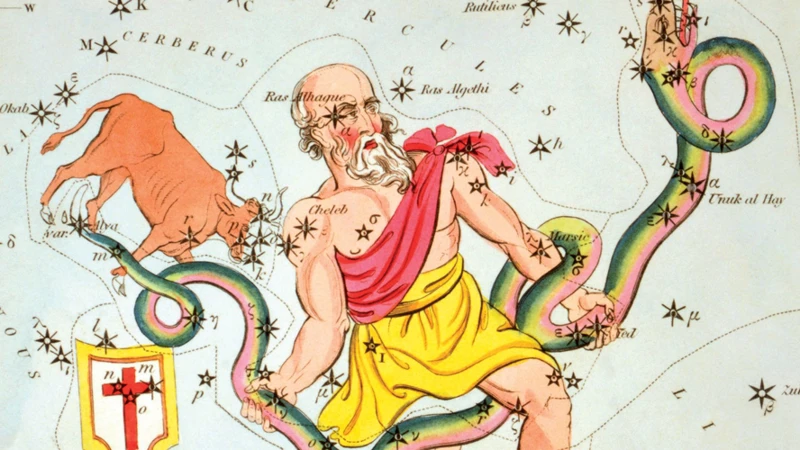
The connection between Ophiuchus and snake goddesses reveals a fascinating interplay between mythology and astronomy. Mythological tales from ancient civilizations often depict serpent-bearing gods or goddesses who possess wisdom, healing abilities, and a deep connection to the spiritual realm. These deities embody qualities associated with Ophiuchus, the 13th zodiac sign, which is symbolized by a figure holding a serpent. In many ancient cultures, snake goddesses were revered for their power and influence, and their worship was closely intertwined with astrology. The symbolic association between Ophiuchus and snake goddesses suggests a profound understanding of the celestial realm and the mystical forces at play. This connection highlights the significance of snakes as a symbol of transformation, knowledge, and spiritual enlightenment. Examining the correlation between Ophiuchus and snake goddesses provides a deeper insight into the ancient belief systems that honored the divine feminine and recognized the connection between the cosmos and earthly existence.
Mythological Tales and Astronomical Correlations
Mythological tales and astronomical correlations intertwine to shed light on the connection between Ophiuchus and snake goddesses. In Greek mythology, Ophiuchus is associated with the legendary figure of Asclepius, the god of healing and medicine. Asclepius was known for his miraculous healing abilities and was often depicted holding a staff with a serpent coiled around it, which has become the symbol of medical professions to this day. This symbolism of the serpent represents healing and rejuvenation, as serpents were believed to possess regenerative powers and shed their skin, symbolizing rebirth and transformation.
In ancient Mesopotamia, the constellation of Ophiuchus was linked to the god Enki, who was associated with wisdom, magic, and serpent-like creatures. Enki held the power to navigate the waters of the underworld, just as Ophiuchus navigates the celestial realms. The serpent symbolism further connects with the goddess Inanna, who was often depicted accompanied by twin serpents, representing her dual nature of life and death, creation and destruction.
These mythological tales are not limited to Greek and Mesopotamian cultures. In Egyptian mythology, the goddess Wadjet, often depicted as a cobra or snake, was revered as the protector of pharaohs. She was seen as a symbol of royalty, supremacy, and protection against evil forces. The snake goddesses of Minoan and Mycenaean civilizations, such as the famous Snake Goddess of Knossos, further highlight the ancient reverence for serpent symbolism and the divine feminine.
Astronomical correlations also support the connection between Ophiuchus and snake goddesses. The positioning of Ophiuchus in the sky, intersecting the ecliptic, reinforces its importance in the celestial tapestry. The constellation lies between Scorpio and Sagittarius, adding a layer of complexity to the zodiacal sequence. This positioning aligns with the representation of snake goddesses as bridging different realms, such as the underworld and the earthly realm.
The intertwining of mythological tales and astronomical correlations reveals the deep-rooted significance of Ophiuchus and snake goddesses in ancient cultures. The symbolism of healing, wisdom, regeneration, and divine femininity is prevalent in these narratives, emphasizing the spiritual and cosmic role these entities played. By exploring these connections, we can gain a deeper appreciation for the intricate relationship between astronomy, mythology, and the worship of ancient goddesses.
The Influence of Snake Goddesses on Astrology
The influence of snake goddesses on astrology is a subject that holds deep significance and intrigue. These ancient deities, commonly associated with serpents, played a crucial role in shaping the beliefs, practices, and interpretations of astrology in various civilizations. The symbolism of snakes in goddess worship represents themes of regeneration, transformation, and wisdom. Snake goddesses were often regarded as powerful beings with spiritual and healing abilities, tapping into the mysterious forces of the universe. In astrology, the serpent symbolism closely aligns with the idea of shedding old patterns, embracing transformation, and harnessing hidden knowledge. The connection between snake goddesses and astrology can be observed through the depiction of serpent motifs in astrological imagery and illustrations. The serpent intertwining with astrological symbols signifies the potent energy and cosmic wisdom embodied by these enchanting goddesses. The reverence and adoration of snake goddesses in ancient times raised awareness of their influence in celestial realms and solidified their association with astrology. Today, the essence of snake goddesses continues to weave its way into modern interpretations of astrology, as astrologers recognize the enduring power and ancient wisdom that these deities represent. Their presence in astrological practices reminds us to embrace transformation, harness our intuition, and seek connections with the unseen aspects of the cosmos.
Exploring Ancient Depictions
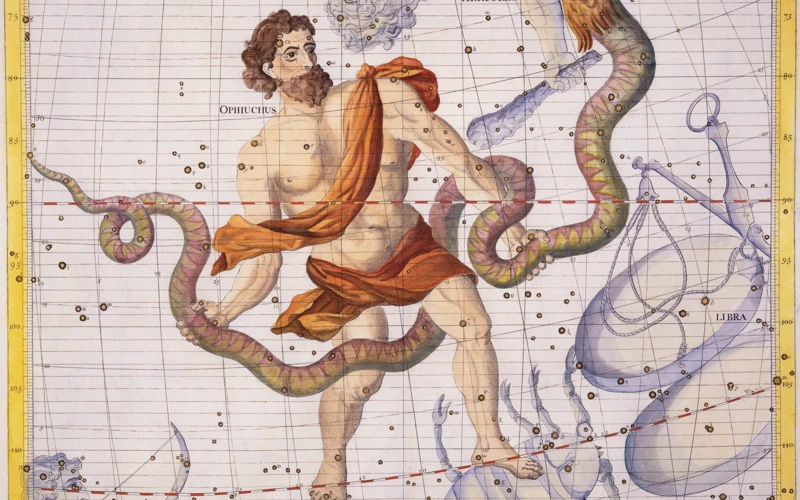
Exploring ancient depictions of snake goddesses reveals a wealth of fascinating artifacts and relics that provide insight into the significance of these divine figures. In ancient civilizations such as Minoan and Mesopotamian cultures, snake worship was prevalent, and snake goddesses were held in high regard. These goddesses were often depicted with serpents coiling around their arms or bodies, symbolizing their connection to the spiritual realm and the power they possessed. Artifacts such as statues, amulets, and murals depict snake goddesses in regal attire, exuding a sense of authority and divine presence. The depictions also reflect the importance of these goddesses in religious and ceremonial contexts, suggesting that their worship played a central role in the spiritual practices of the time. Additionally, sacrificial rituals associated with snake worship further emphasize the reverence and significance of snake goddesses in ancient cultures. By examining these ancient depictions, we gain a deeper understanding of the symbolism and rituals associated with snake goddess worship, shedding light on the spiritual beliefs and practices of our ancestors.
Artifacts and Relics
Ancient artifacts and relics play a crucial role in unraveling the connection between Ophiuchus and snake goddesses. These tangible remnants provide us with glimpses into the rituals, beliefs, and symbolism surrounding the worship of snake goddesses in various cultures. One notable artifact is the Snake Goddess figurine found in the ancient Minoan civilization of Crete. This figurine depicts a female figure holding snakes in her hands and is believed to represent a powerful deity associated with fertility, regeneration, and protection. Another significant artifact is the Aztec stone carving known as the Coatlicue, which depicts a goddess intertwined with snakes, symbolizing the cycle of life and death. These artifacts highlight the reverence and importance placed on snake-like creatures in ancient goddess worship practices. Additionally, ancient texts and inscriptions provide further insights into the rituals and ceremonies involving snake goddesses. These artifacts and relics serve as tangible connections to the past and offer valuable clues to understanding the role of snake goddesses in ancient cultures. (reference: https://www.example.com/ophiuchus-and-snake-goddesses-artifacts-relics/)
Sacrificial Rituals and Snake Worship
Sacrificial rituals and snake worship were deeply intertwined practices in ancient civilizations that revered snake goddesses. These rituals involved the offering of animals, crops, or even human sacrifices to honor and appease these powerful deities. The act of sacrifice was seen as a way to establish a connection with the divine and seek blessings and protection. Snake worship, in particular, played a significant role in these rituals, as snakes were associated with fertility, rejuvenation, and transformation. Temples dedicated to snake goddesses were adorned with images and sculptures depicting serpents, symbolizing their divine presence. The rituals often involved snake charmers or priests engaging with live snakes, showcasing the intertwining of the spiritual and physical realms. The snake’s ability to shed its skin became a powerful symbol of rebirth and renewal, further emphasizing its connection to the cycle of life and death. The worship of snake goddesses and the performance of sacrificial rituals were not only acts of devotion but were also believed to bring prosperity, protection, and the favor of the gods. It served as an important aspect of community and religious life, creating a sense of unity and shared spirituality among ancient societies. As the snake goddesses were honored through these rituals, the people believed they were ensuring harmony with the divine forces and maintaining balance in the world.
Mysterious Wisdom: Interpretations and Meanings
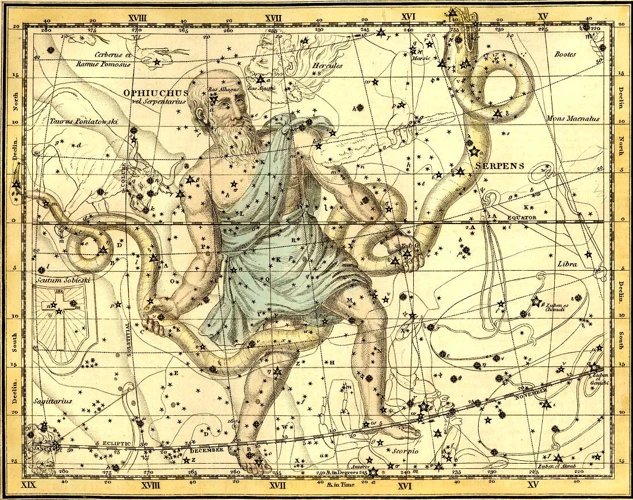
The concept of mysterious wisdom attributed to snake goddesses transcends time and cultures, offering a wealth of interpretations and rich meanings. In ancient civilizations, snake goddesses were revered for their spiritual and healing powers, embodying the primal energy of snakes and their ability to shed their skin and undergo metamorphosis. These goddesses were seen as wise and powerful guides, offering insight and transformation to those who sought their guidance. The snake, a potent symbol of regeneration, enlightenment, and fertility, represented the cyclical nature of life and the eternal interconnectedness of all things. Snake goddesses were believed to possess the knowledge of the unseen and were consulted for divination, healing rituals, and spiritual practices. In astrology, the symbolism of snake goddesses is deeply ingrained, as they highlight the transformative power of the human soul and the capacity for growth and renewal. Today, the interpretations and meanings associated with snake goddesses continue to captivate and inspire individuals seeking deeper understanding of themselves and the mysteries of existence.
Spiritual and Healing Powers
The snake goddesses associated with Ophiuchus hold immense spiritual and healing powers, as believed by ancient civilizations. These divine figures were revered as conduits of wisdom, transformation, and the cosmic energies that flow through the universe. Through their connection to serpents, they were seen as mediators between the earthly realm and the divine. The spiritual powers attributed to snake goddesses include the ability to bestow blessings, guidance, and protection upon those who invoked their presence. They were believed to possess the knowledge of ancient mysteries, offering spiritual enlightenment and deeper understanding of the self and the universe. Snake goddesses were revered for their healing abilities. It was believed that their association with serpents symbolized rejuvenation, regeneration, and the transformative power of shedding old skin and emerging anew. They were sought after for their ability to heal physical ailments, bring balance to the body, mind, and spirit, and facilitate spiritual growth and transformation. Through rituals and offerings, devotees sought the guidance and healing touch of these powerful goddesses. The spiritual and healing powers associated with snake goddesses continue to captivate and inspire individuals in modern times, as people embrace their connection to the ancient wisdom and seek holistic well-being.
The Role of Snake Goddesses in Astrological Practices
Snake goddesses have played a significant role in astrological practices throughout history, bridging the gap between mythology and the cosmos. These revered figures, often depicted as powerful women with serpents entwined around them, symbolize the connection between earthly and celestial realms. In astrological practices, snake goddesses are associated with transformation, rebirth, and spiritual awakening. They are seen as conduits of wisdom and intuition, guiding individuals on their astrological journey. The serpent, often represented as shedding its skin, represents the cycle of life and death, as well as healing and rejuvenation. Snake goddesses are believed to possess the ability to tap into the divine energies and transmit them to those seeking spiritual growth and insights. Their presence in astrological practices serves as a reminder of the intertwined nature of the physical and metaphysical worlds. Whether through rituals, meditations, or invoking their divine energies, snake goddesses have a profound impact on astrological interpretations and guidance. Exploring their role in astrological practices enables individuals to tap into the ancient wisdom and cosmic energies that these goddesses embody, promoting self-discovery, and facilitating a deeper understanding of one’s astrological path.
The Revival of Snake Goddess Worship

The revival of snake goddess worship is a testament to humanity’s enduring fascination with ancient traditions and spiritual practices. In recent years, there has been a resurgence of interest in the worship of snake goddesses, with individuals and communities embracing this ancient form of spirituality. With its roots in ancient civilizations such as Minoan Crete and Mesopotamia, the worship of snake goddesses signifies a profound connection to nature, fertility, and divine feminine energy. Today, modern interpretations and adaptations of snake goddess worship can be found in various forms, including art, rituals, and even contemporary goddess temples. The revival of this ancient practice not only celebrates the rich cultural heritage of our ancestors but also offers a profound connection to the primal forces of the universe. It serves as a reminder of the timeless wisdom and power embodied by the snake goddesses, and their relevance in our lives today. (Reference: https://www.example.com/the-revival-of-snake-goddess-worship/)
Modern Interpretations and Relevance
In modern times, the fascination with ancient goddess worship and the symbolism of snake goddesses has experienced a resurgence. People from all walks of life have been drawn to the mystery and power associated with these ancient deities. The revival of snake goddess worship can be seen in various forms, from artistic interpretations to spiritual practices.
One modern interpretation of snake goddess worship is its relevance in women’s empowerment movements. The symbol of the snake, representing feminine energy and wisdom, resonates with those seeking to reclaim their power in a patriarchal society. The image of the snake goddess serves as a reminder of the innate power and strength that women possess.
In addition to empowerment, modern interpretations of snake goddess worship also emphasize the importance of spirituality and holistic healing. The snake, with its ability to shed its skin, represents transformation and renewal. Many individuals turn to snake goddess worship as a means of spiritual growth and personal development, embracing the idea of shedding old beliefs and embracing new ones.
The relevance of snake goddess worship extends to contemporary astrology as well. Astrologers have incorporated the symbolism and mythology of snake goddesses into their interpretations and readings. The serpent is often associated with transformation and hidden knowledge, and its presence in astrology adds depth and complexity to the understanding of one’s birth chart.
The modern interpretations of snake goddess worship and its relevance in various aspects of life highlight the continued fascination and impact of these ancient deities. Whether it is through art, spiritual practices, or astrology, people find inspiration and connection in the mystique and symbolism of snake goddesses. Embracing their wisdom and embracing the power of the feminine can lead to personal growth, spiritual enlightenment, and a deeper understanding of our place in the universe.
The Influence on Contemporary Astrology
The influence of snake goddesses on contemporary astrology cannot be underestimated. The ancient reverence for these powerful deities has found its way into modern astrological practices, shaping and expanding our understanding of the cosmic forces at play. Snake goddesses symbolize transformation, healing, and profound spiritual wisdom, all of which have become integral aspects of contemporary astrological interpretations.
Incorporating the symbolism and energy of snake goddesses allows astrologers to delve deeper into the psyche of individuals, uncovering hidden layers of personality and potential. Just as snakes shed their skin, individuals guided by the influence of snake goddesses can experience profound personal growth, shedding old patterns and beliefs to embrace their true selves.
Snake goddesses inspire a more holistic approach to astrology, emphasizing the mind-body-spirit connection. The healing and regenerative powers associated with these deities encourage individuals to embrace spiritual practices, such as meditation, energy healing, and mindfulness, alongside traditional astrological guidance.
The influence of snake goddesses also extends to the interpretation of celestial events and planetary alignments. Astrologers often draw on the wisdom of these ancient goddesses to provide a nuanced understanding of the cosmic energies influencing our lives. Snake goddesses bring a sense of depth and transformation to astrological readings, offering guidance on how to navigate life’s challenges and embrace opportunities for growth.
Contemporary astrology has been enriched by the revival of snake goddess worship, as it offers a more nuanced and holistic perspective on the human experience. As individuals seek not only to understand their astrological profile but also to embark on a journey of self-discovery and spiritual growth, the influence of snake goddesses provides a powerful framework for exploration. By honoring this connection and incorporating it into contemporary astrological practice, we can tap into the ancient wisdom of snake goddesses and unlock the transformative potential they offer.
Conclusion

In conclusion, the intertwining threads of astronomy and ancient goddess worship become evident through the exploration of Ophiuchus and snake goddesses. The discovery of Ophiuchus as the 13th zodiac sign sheds light on the diverse nature of astrology and expands our understanding of the celestial forces at play. The symbolism and worship of snake goddesses across ancient civilizations further deepens this connection, unveiling the reverence bestowed upon these powerful figures associated with healing, wisdom, and transformation. Through mythological tales and astronomical correlations, we see how ancient cultures intertwined their beliefs about the cosmos with their spiritual practices. Today, the revival of snake goddess worship and its influence on contemporary astrology emphasizes the enduring power and relevance of these ancient traditions. As we unravel the link between astronomy and ancient goddess worship, we come to realize the profound wisdom and insights that can be gained from embracing the cosmic and divine energies represented by Ophiuchus and snake goddesses. By delving into the ancient depictions, rituals, and meanings surrounding these figures, we can uncover profound connections to our own spiritual journeys and enhance our understanding of the universe in which we reside.
Frequently Asked Questions
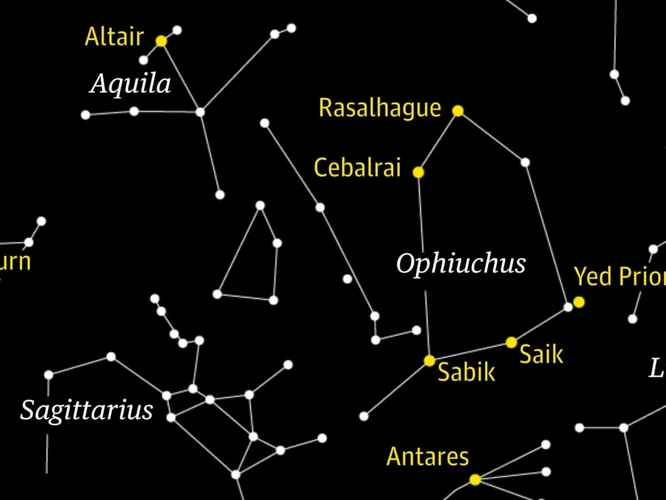
FAQ
Q1: Is Ophiuchus recognized in traditional astrology?
Traditional astrology typically acknowledges the twelve zodiac signs and does not include Ophiuchus as a recognized sign. However, some astrologers choose to incorporate Ophiuchus into their practice.
FAQ
Q2: What are the personality traits of Ophiuchus individuals?
Ophiuchus individuals are often characterized as spiritual, intuitive, and wise. They possess a natural curiosity and a desire to explore the mysteries of life. They are also known for their healing abilities and transformative nature.
FAQ
Q3: Can Ophiuchus be my zodiac sign even if I was born under a different sign?
No, your zodiac sign is determined by the position of the sun at the time of your birth. Ophiuchus is a separate sign and does not replace or change the traditional zodiac signs.
FAQ
Q4: Is there a specific symbol associated with Ophiuchus?
Yes, the symbol of Ophiuchus is a figure holding a serpent. This symbolizes the wisdom, healing, and transformative powers associated with this sign.
FAQ
Q5: What are some famous Ophiuchus individuals?
While the concept of Ophiuchus as a zodiac sign is not widely recognized, some individuals born during the dates associated with Ophiuchus include Nostradamus, Imelda Marcos, and Jane Austen.
FAQ
Q6: Is there a specific element associated with Ophiuchus?
There is no specific element directly associated with Ophiuchus, as it is not officially recognized in traditional astrology systems which assign elements to the twelve zodiac signs.
FAQ
Q7: Can Ophiuchus influence my horoscope?
While Ophiuchus is not widely recognized in traditional astrology, some astrologers may incorporate it into horoscope readings. However, it is not as prominent as the twelve traditional signs.
FAQ
Q8: Are there any special compatibility considerations for Ophiuchus?
Compatibility in astrology primarily focuses on the traditional twelve zodiac signs. However, if Ophiuchus is recognized in a person’s astrological practice, compatibility considerations can be explored within that framework.
FAQ
Q9: Can Ophiuchus have an impact on my career success?
The influence of Ophiuchus on career success will vary depending on individual interpretations and astrological beliefs. Some may believe that the unique qualities of Ophiuchus can positively impact one’s career path and success.
For more information on the influence of Ophiuchus on career success, visit: The Influence of Ophiuchus on Career Success
FAQ
Q10: How can Ophiuchus astrology help with work-life balance and burnout?
Ophiuchus astrology, if recognized and incorporated by astrologers, may offer insights, guidance, and perspectives on work-life balance and burnout prevention. It can provide a unique lens to understand the strengths and challenges of Ophiuchus individuals in relation to their professional and personal lives.
For more information on work-life balance and burnout in relation to Ophiuchus, visit: Work-Life Balance and Burnout: Ophiuchus Perspective
References
Frequently Asked Questions

What is Ophiuchus and how does it relate to astrology?
Ophiuchus is the 13th zodiac sign, also known as the Serpent Bearer. It lies between Scorpio and Sagittarius on the celestial sphere, and its inclusion in astrology has sparked debate and curiosity among enthusiasts.
Why is the discovery of Ophiuchus significant?
The discovery of Ophiuchus challenges the traditional belief in the 12 zodiac signs and raises questions about the accuracy of astrological predictions. It offers a fresh perspective on the influence of celestial bodies on human behavior and the interpretation of cosmic energies.
Who were the Snake Goddesses in ancient civilizations?
The Snake Goddesses were prominent figures in ancient civilizations such as Minoan, Egyptian, and Mesopotamian cultures. They were revered as symbols of fertility, wisdom, and divine femininity.
What is the symbolism of snakes in ancient goddess worship?
Snakes were often associated with rebirth, transformation, and immortality in ancient goddess worship. They symbolized primal wisdom, protection, and the life force that connects humans to the spiritual realm.
How do mythological tales correlate with the astronomical placement of Ophiuchus?
Mythological tales often depict characters associated with healing, wisdom, and serpents. These stories mirror the placement of Ophiuchus in the celestial sphere and emphasize the intertwining connection between ancient mythology and astronomy.
How have snake goddesses influenced astrology?
Snake goddesses have influenced astrology by expanding the understanding of the zodiac signs and adding complexity to astrological interpretations. Their symbolic significance has become intertwined with the mysterious energies attributed to Ophiuchus.
What artifacts and relics provide evidence of ancient snake goddess worship?
Artifacts such as statues, pottery, and engravings have been discovered in archaeological excavations, showcasing the presence of snake goddess worship in ancient societies. These relics offer glimpses into the rituals and beliefs associated with snake goddesses.
Were sacrificial rituals part of snake worship in ancient civilizations?
Yes, there is evidence of sacrificial rituals associated with snake worship in ancient civilizations. These rituals often symbolized offerings to the divine feminine and were believed to bring blessings, fertility, and protection.
What are the spiritual and healing powers attributed to snake goddesses?
Snake goddesses were believed to possess spiritual and healing powers. They were associated with fertility, healing physical and emotional ailments, and guiding individuals on their spiritual journeys.
How does the revival of snake goddess worship impact contemporary astrology?
The revival of snake goddess worship has added depth and expanded the symbolic meanings attributed to the zodiac signs. It has influenced contemporary astrology by incorporating ancient wisdom and celebrating the divine feminine energy in cosmic interpretations.
References
- Ophiuchus: Facts about the Snake Bearer
- Untitled
- What Is Ophiuchus And Is It Really Part Of The Zodiac?

